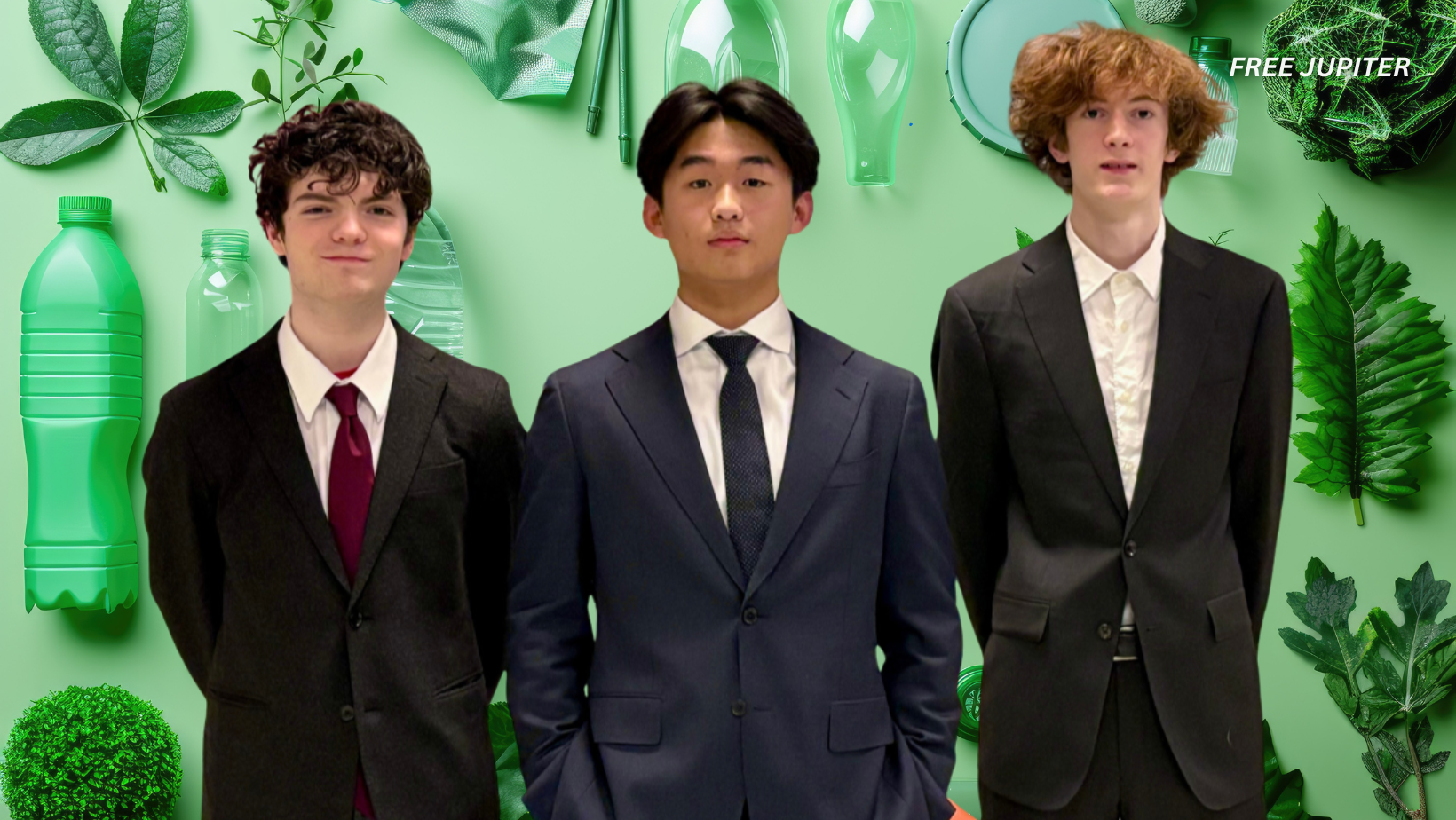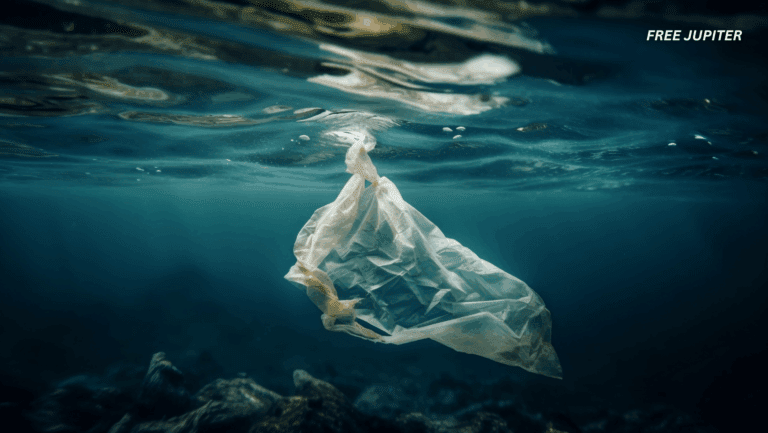Friendly Note: FreeJupiter.com shares general info for curious minds 🌟 Please fact-check all claims—and always check health matters with a professional 💙
In an age where oceans are choking on plastic, landfills are spilling over, and microplastics are finding their way into everything from fish fillets to human bloodstreams, the world is crying out for alternatives.
And yet, most sustainable solutions either come with a hefty price tag or fail to scale. But now, a surprising—and refreshingly hopeful—innovation has emerged not from a corporate R&D department or an Ivy League think tank, but from a high school classroom in New York City.
Meet three ambitious teenagers: Zhi Han (Anthony) Yao, Flint Mueller, and James Clare—students with a knack for robotics, a flair for creative problem-solving, and a shared frustration over broken parts arriving in the mail. Instead of brushing it off, they asked the big question: What if we could package fragile items in something safer, smarter, and plastic-free?
Their answer? A clever little invention called Kiriboard—a lightweight, foldable cardboard solution that mimics the shock-absorbing power of bubble wrap, but without the environmental baggage.
Designed using principles borrowed from kirigami, the Japanese art of precision folding, Kiriboard has the potential to revolutionize how goods are shipped across the world.
What started as a DIY school project has now turned into a globally recognized innovation that’s already making waves in the sustainable tech space. Their invention not only snagged a major environmental prize—but it’s also catching the eye of corporate giants who just might be ready to ditch plastic for good.
The Birth of a Brilliant Idea: One Broken Motor, Many Possibilities
It all began with a busted delivery. The trio, all members of Stuyvesant High School’s robotics team, had ordered high-end robot motors—priced around $200 apiece. But when the package arrived, they were disappointed to find the delicate brass pins bent and damaged. It wasn’t the product’s fault. It was the packaging.
That shipping fail triggered a lightbulb moment.
“Clearly, the packaging wasn’t good enough,” said Mueller. Instead of complaining, they saw an opportunity to innovate. Clare, thinking like a true engineer, recalled how cars are designed with crumple zones—areas built to absorb the force of a crash so that passengers stay safe. “Why couldn’t packaging be designed with the same idea in mind?” he wondered.
That thought planted the seed for what would become Kiriboard.
What Exactly Is Kiriboard?
Kiriboard is not your standard box filler. It’s a lightweight, foldable, cardboard-based structure, inspired by kirigami—the Japanese art of intricately folding and slicing paper. But this isn’t origami for fun—it’s physics in action.
The Kiriboard is cut into clever lattice-like patterns. These slits and folds give it flexibility and strength, allowing it to absorb impact while hugging and cushioning fragile items. It’s a bit like cardboard bubble wrap, but smarter, sleeker, and significantly better for the planet.
Read more: The Largest Single Organism On Earth Is Slowly Being Eaten
Plastic Packaging: The Hidden Polluter in Your Mailbox
Let’s face it—most of us don’t give a second thought to the bubble wrap, Styrofoam peanuts, or foam inserts that come with our online orders. They get ripped off, thrown out, and forgotten.
But here’s the problem: those materials don’t go away.
They slowly break down into microplastics—tiny, invisible fragments that infiltrate ecosystems, animals, and even human bodies. Microplastics have now been found in rainwater, sea salt, seafood, drinking water, and even human blood.
Alarming new research has linked them to potential health problems, including inflammation, hormone disruption, and increased risks of heart disease and early-onset cancers like colon cancer.
While some companies have made eco-conscious pledges, most still rely heavily on plastic-based packaging. And for good reason—it’s cheap, light, and durable. But what if there was something just as functional, but biodegradable and sustainable?
Enter Kiriboard.
Winning the Earth Prize—and Global Recognition
The teens submitted their invention to the Earth Prize, an international competition celebrating environmental innovation among students. On April 8, 2025, they were named one of the global winners—out of hundreds of projects from around the world.
The recognition came with a $25,000 reward, split between the students and their school. Their winnings will be invested into buying a CNC router (a computer-controlled cutting machine), which will allow them to scale up their designs with laser precision.
They’ll also continue crafting more prototypes and testing how well their creation performs under pressure—literally.
Their goal? To partner with companies like Amazon, FedEx, Home Depot, and even the United States Postal Service—essentially the packaging giants of the modern world.
Read more: Scientists Discover Animals Have a Mysterious ‘Sixth Sense’, Changing Evolutionary Theories
Cardboard, Drop Tests, and the Matrix
The team didn’t have a corporate lab or tech startup. They had scavenged cardboard, classroom support, and a little ingenuity.
After drawing up about nine initial blueprints, they built four solid prototypes. Each design had unique lattice structures and strategically placed cuts that would allow the cardboard to flex and absorb shock. But how could they know if it worked?
They put their designs through the wringer: dropping heavy objects like staplers, soda cans, metal water bottles, and rolls of tape from different heights onto their prototypes. Their mission: see just how much weight the packaging could handle before it broke.
“The water bottle caused the most damage,” Clare laughed, “but not nearly as much as we expected.”
The most promising design included four angled support legs and a bendable center—what they nicknamed “The Matrix”. It’s the part that actually cradles the product being shipped, absorbing shocks from all sides. “The Matrix molds around the item, making sure it doesn’t move or shake inside the box,” Yao explained.
Sustainability With a Side of Savings
What makes Kiriboard even more promising is that it might save companies money. Because cardboard is cheap and recyclable, Kiriboard could become a cost-effective alternative to foam and plastic if mass-produced.
Plus, using a sustainable, branded packaging material could boost a company’s reputation with environmentally-conscious customers. In an era where people actively seek green alternatives, Kiriboard could be a win-win—for both profits and the planet.
Not Just a School Project Anymore
While the teens are still perfecting their design, the buzz around Kiriboard is growing. They’ve been featured in national media, and interest from shipping companies is slowly trickling in. Their teacher, Jerry Citron, couldn’t be prouder.
“This is the kind of project that doesn’t just win awards—it changes things,” he said. “Something like this is the wave of the future.”
And these teens are ready to ride it.
Read more: Voyager Probes Stumble Upon a Cosmic ‘Wall of Fire’ Outside Of Our Solar System
The Bigger Picture: Youth Innovation in Action
Kiriboard is one of many ideas proving that young minds can tackle serious global challenges. Other Earth Prize winners this year include a biodegradable menstrual pad made from banana fibers, a plastic-eating bacteria discovery, and a filter that removes microplastics from tap water.
In a world often overwhelmed by bad environmental news, these projects offer hope—and proof that innovation doesn’t always need a billion-dollar lab. Sometimes, it just needs three teenagers, some broken motors, and a pile of cardboard.










